Tả Van Village, one of the few villages of the ethnic minorities in the mountains of Sapa that we can easily reach. In Tả Van, the life of the locals is still very simple, peaceful, not noisy, and urbanized like other villages. Take a few short minutes with Cuồng to learn about Tả Van and the cultural characteristics of the ethnic people here.
Nowadays, when people travel to Sapa, they often say that Sapa has become like a city, crowded and bustling. Everywhere you look, there are concrete buildings like restaurants and hotels, no longer the simple and rustic charm of the ethnic minority villages with thatched roofs and mud walls nestled in the morning mist on the hillsides and mountains. This is because people tend to wander around the central area of Sapa town and are not aware of the many remote and primitive villages of the ethnic minorities.If you go about 12 km outside the town, you will reach Tả Van village, a village in Sapa, Lào Cai. Unlike Cát Cát village, Tả Van is far from the center of Sapa town, so it remains extremely pristine, reflecting the authentic life of the mountainous ethnic people here. In Tả Van, you will immerse yourself in the simple life of the Mông, Dao Đỏ, and Giáy ethnic groups. You will experience a peaceful life, far from the noisy and crowded city. If you have traveled to Sapa and are looking to slow down and find inner peace, cross the icy stream road to Tả Van village!
Where is Tả Van Sapa located?
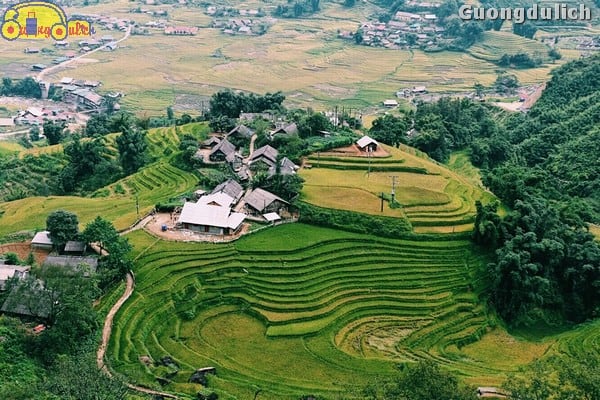
Tả Van village is located in Tả Van commune, Sapa district, Lào Cai province. As Cuồng just shared, Tả Van village is only about 12 km from Sapa town.
According to the Mông ethnic language, Tả Van means a large arc, as the village leans against the Hoàng Liên Sơn mountain range and faces the winding Mường Hoa stream.
Tả Van village is the living place of the Mông ethnic people for generations, as well as the Red Dao and Giáy ethnic groups. If you want to admire the beauty of the entire Mường Hoa valley, you must visit Tả Van village.
How to get to Tả Van Sapa village
Cuồng knows that many people who travel to Sapa often stay in hotels in the central area of Sapa town, then set off to tourist destinations in Sapa such as Cát Cát village, Mường Hoa valley, and Tả Van village. Since Tả Van village is about 12 km from the center of Sapa town, Cuồng often sees tourists hiring motorbike taxis, taxis, or cars to get to Tả Van village.
For those who travel to Sapa independently, you can ask the hotel where you stay in the central area of Sapa to help you rent a motorbike to Tả Van village. As far as Cuồng knows, many hotels in Sapa offer rental services for vehicles and guide tourists to various tourist spots in Sapa. If you are confident in driving, you can rent a self-driving vehicle, which gives you the freedom to stop and go whenever you want. If you are afraid of getting lost or not very experienced in mountain driving, you can hire a motorbike taxi. It’s better to hire a motorbike taxi because Cuồng finds the road quite narrow and winding, with many rough and rocky sections that are difficult to navigate.
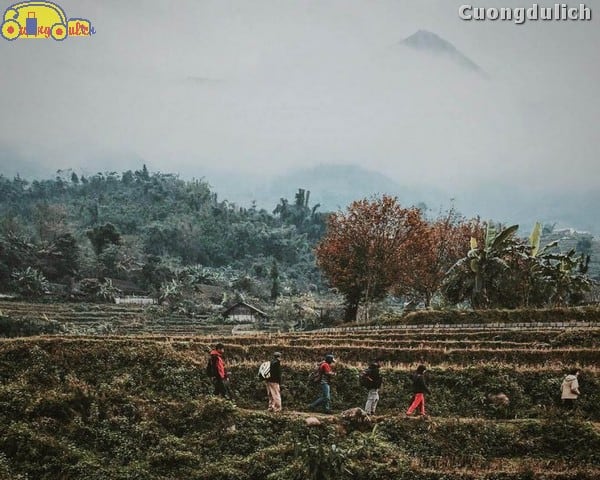
For those of you going on a Sapa tour package, it’s much simpler as tour companies have prepared transportation, drivers, and guides to take you to the sightseeing spots.
For those of you who want to rent a taxi or car to get to Ta Van village, Cuong suggests that you should rent a car with less than 16 seats, as large cars are not allowed in the village. However, Cuong still sees many people choosing to ride a motorbike to Ta Van village because it allows for more comfortable photo opportunities compared to driving a car.
Cuong will guide you from the center of Sapa town to Ta Van village, in case any of you want to find your own way. From Sapa town, you move through May Bridge Street, following the flow of the Muong Hoa stream to reach Ta Van village. From Muong Hoa street, you go through the inner city of Sapa until you reach the ticket checkpoint. From this checkpoint, you will be guided on the way to Ta Van village. At the beginning of the village, there is a red iron bridge crossing the Muong Hoa stream leading into Ta Van village. Furthermore, due to the development of tourism, Sapa has opened up many roads, each leading to a different village, so for backpackers or those who like to explore, you can follow these paths to other villages.
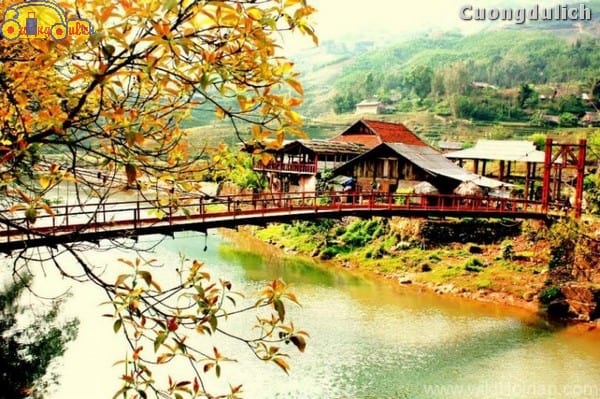
On the way to Ta Van village, you will pass by many famous tourist spots in Sapa such as the ancient rock field. For those who are not familiar, let me introduce you to this ancient rock field. The Sapa ancient rock field covers an area of about 8 square kilometers, discovered in 1925. The area of the Sapa ancient rock field is vast with nearly 200 rock blocks, but what is special about these rocks is their incredibly diverse and unique shapes such as stairs, human figures, roads, and writings. Today, this ancient rock carving site has been classified as a national monument and is a unique heritage of the ancient Vietnamese people. Many scientists both domestic and foreign have come to this ancient rock field to study the strange writings on the rocks, but have not yet discovered their origins or the process of their formation. This ancient rock field is located in the area of Lao Chai commune – a place with incredibly beautiful mountainous landscapes. So Cuong thinks that on the way to Ta Van village, before reaching the destination, you should spend a whole day exploring Lao Chai village.
The final way to reach Ta Van village is trekking, which means walking to Ta Van village. Cuong sees that many Western backpackers use this method a lot. Along the way, Cuong met many people walking, taking the opportunity to admire the Muong Hoa valley scenery and take plenty of selfies. This walking route is a bit challenging, but after overcoming all the difficulties, reaching the destination will be worth it. The road is now easy to walk on, paved with asphalt to the center of the village. You can ask the H’Mong girls going to Sapa market to accompany you to the village. Cuong is sure that chatting with the kind-hearted ethnic girls while walking will shorten the long journey, and you will learn a lot more about the lives of the ethnic people.
Ticket price for Ta Van village in Sapa
A few years ago, to visit Ta Van village, tourists did not need to pay for tickets. The entrance gate was not strictly controlled. But now, most Sapa tourist spots charge entrance fees, so Ta Van village is no exception. The purpose of charging entrance fees to visit Ta Van village is to support the livelihoods of the local residents. The money from ticket sales is also used for repairing and maintaining the road leading to the village.
When Cuong visited Sapa earlier this year, the ticket price to visit Ta Van village was 75,000 VND per adult. However, the ticket checkpoint is not very strict, so on days with bad weather or around noon, there may not be anyone checking tickets, allowing you to visit for free. Many people also take taxis to the village without being checked for tickets! Or you can tell the ticket inspectors that you are visiting the homes of Mr. A, B, C in Ta Van village, and they will let you in without any issues.
Let’s explore what Ta Van village in Sapa has to offer!
1. Terraced fields
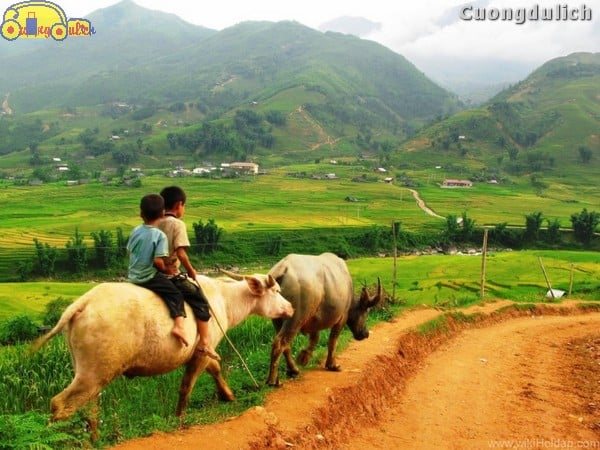
When it comes to the outstanding scenery of Ta Van village, it would be a big mistake to overlook the terraced fields. These terraced fields, created by the hard work of generations of ethnic people, wind around the hillsides and mountains, spreading out as far as the eye can see, seemingly without end. The terraced fields, along with the majestic mountains and lush greenery, create a magnificent natural landscape. Standing here, amidst the vast land and sky, breathing in the fresh, pristine air of the mountains, you will feel like you are in a wild, untouched place, untouched by industrialization, free from the hustle and bustle of urban life. If you want to escape for a few days, “leave everything behind and go,” to run away for just a few days from the hectic pace of the city life, to slow down, to reconnect with your true self, then Ta Van Sapa is a destination you should definitely visit, I believe so.
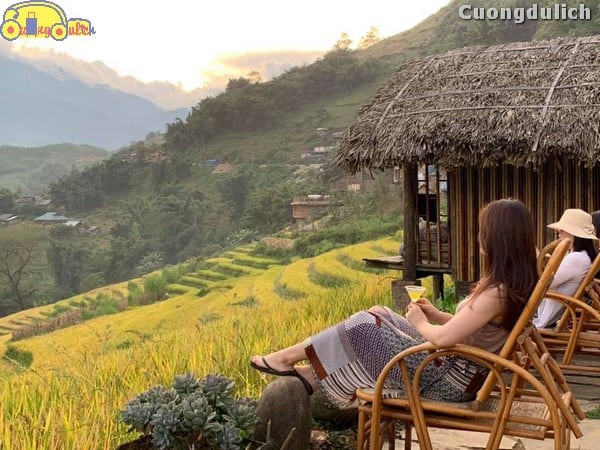
You can visit the terraced fields in Ta Van village in any season of the year and capture some unforgettable check-in photos. In the village during the rice transplanting season, you will see the terraced fields like giant silver-white mirrors, reflecting the majestic mountains and forests. In the summer, the terraced rice fields are covered in lush green, pleasing to the eyes. Autumn brings the golden harvest season, attracting many tourists to Ta Van to admire the shimmering golden rice fields, a sight that promises a bountiful harvest. In the evening, watching the children herding buffaloes back home creates a familiar scene of rural Vietnam that Cuong hasn’t seen in a long time. If you visit Ta Van in the spring, you will see traditional houses mixed with the fresh pink of cherry blossoms and the white of plum and apricot blossoms. The sky in Ta Van with dust rain and mist creates a dreamy atmosphere, making you feel like you are in a dreamland rather than reality. In winter, Ta Van covered in white snow gives you the feeling of being in a pure, pristine paradise, without any impurities.
2. Houses of ethnic minorities in Ta Van village
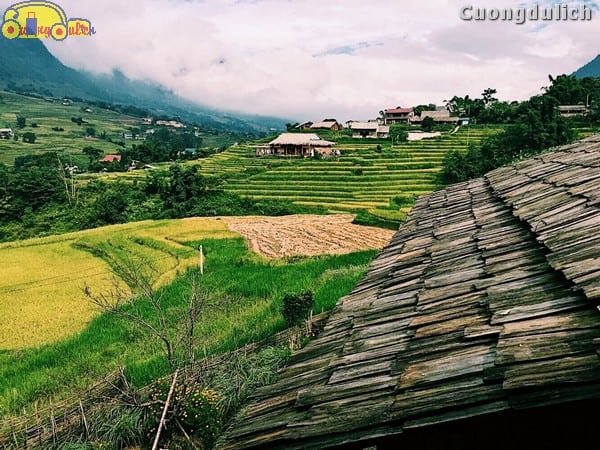
Another deep impression of Ta Van village on Cuong is the ancient houses located close to the road. Although they are considered ancient, these houses are built beautifully, and the residents live in a clean and tidy environment. Some of the beautiful houses that you should visit for photos are Mr. Hoang Din’s house, Lo A Muc’s house… Lo A Muc’s house was built in 1934, so it must be quite old! This is a typical wooden house on stilts of the Giay people. Inside the house, you will see an ancestral altar made of pơmu wood, with a very ancient structure typical of the ethnic people. When traveling, Cuong enjoys immersing himself in the daily life of the local people, learning about their food, daily activities, and traditional customs. Come to Ta Van village, sit by the fireplace in the stilt house, enjoy a glass of corn wine, and listen to the elderly tell stories about their village, you will feel more enlightened and gain more knowledge.
3. Beautiful natural scenery in Ta Van Sapa village
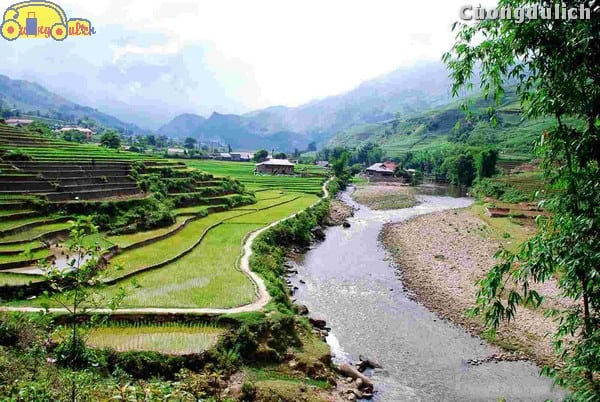
When visiting Ban Ta Van Sapa, you will have the opportunity to admire the stunning natural painting of the Northwest mountainous forest region. You will immerse yourself in the sound of murmuring streams, melodious forest birds, and discover the simple and rustic beauty of the village scenery here. Ban Ta Van in Sapa faces the majestic Muong Hoa stream, nestled against the mountain. The houses here, following the customs of their ancestors, all face northeast to avoid flowing water and not facing the mountain.
4. Experience the life of the people in Ban Ta Van Sapa
If you are tired of tourist spots where wherever you go, there are people following you to sell things, making your trip frustrating and leaving you with no time to enjoy the scenery or relax, then try visiting Ban Ta Van Sapa. The local people do not industrialize tourism in Ta Van. Besides providing food and accommodation for tourists, the people of Ban Ta Van do not make tourism flashy. The lives of the locals continue normally, working in the fields in the morning, weaving in the evening. For the people here, tourists are like pilgrims passing by, coming and going.
The people of Ban Ta Van Sapa are not overly enthusiastic or intrusive, making you uncomfortable, but they are also not indifferent, still giving you a friendly, honest, and hospitable feeling, reflecting the true nature of the people here. When staying at homestays in Ban Ta Van, you will feel like you are in your own home. The local people will not intrude on your precious resting time but will provide you with delicious meals with mountain specialties and all the necessary dining facilities to make your vacation comfortable, convenient, and enjoyable.
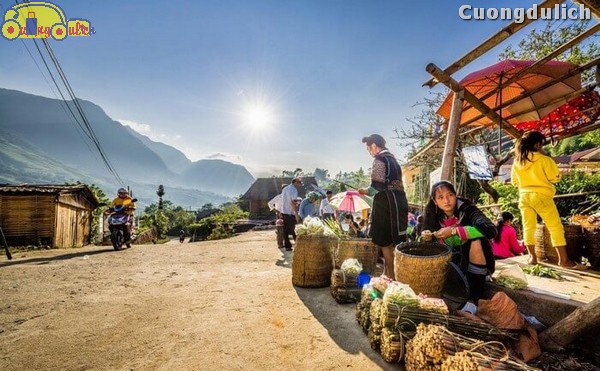
When walking on the roads in Tả Van village, you will come across many ethnic minority children selling handicrafts and cute souvenirs. The prices are very reasonable, Cuồng bought a bracelet for only 10k, and after buying it, even invited the children to take photos together, having a great time. It’s true that even though the children are still very young, they speak English fluently like the wind, Cuồng was really impressed listening to them.
Another interesting thing is that on the roads in Tả Van, you will encounter numerous black H’mong pigs with white swirls on their heads. Each pig is chubby and round, with a big belly. Cuồng stopped to pet them and found them to be very gentle, not aggressive at all, just lying still and letting Cuồng pet them. Perhaps due to the high number of tourists in the area, they have become quite bold and friendly.
5. Check out the beautiful homestays in Tả Van Sapa
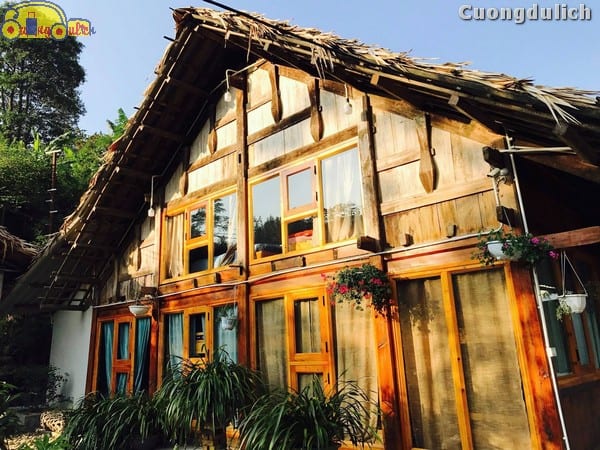
Perhaps visiting Tả Van village for just one day is not enough, you need to find a place to stay for a few days to explore all the interesting places Cuong mentioned above and to learn about the lives of the local people. Therefore, Cuong will introduce you to some nice homestays in Tả Van village. Just like in Cát Cát village, there are now many homestays in Tả Van to serve the needs of both domestic and foreign tourists. Wherever you go, you can find places to rent for overnight stays, either homestays or guesthouses. It can be said that homestays are popping up like mushrooms. So, you no longer have to rush back to Sapa town before dark, nor worry about not having a place to sleep in the village. In Tả Van village, there are now beautiful homestays with full amenities such as bedding and pillows for a good night’s sleep. And the prices are extremely affordable, starting from only 50,000 – 100,000 VND per night, very cheap compared to other famous tourist areas, right?
If you are traveling to Sapa during peak season, you can call ahead to book a homestay in Tả Van village, but Cuong thinks this is not really necessary. There are plenty of homestays in Tả Van for you to choose from, so no need to worry about not finding a place to stay.
Some of the currently popular homestays, where many hot girls check in on Facebook, in Tả Van village include Tả Van Gỗ homestay, Tả Van Hill homestay, Tả Van Family homestay, Lá Dao Homestay…
See more about Sapa:
- Detailed Review of 20 Sapa Tourist Destinations for First-Time Visitors to Sapa
- 10 Hottest Sapa Tourist Destinations – Save Now to Avoid Regrets
- Top Highlights of Sapa Tourist Attractions
6. Pose with traditional ethnic costumes
When you wear traditional costumes of ethnic minority girls, you will feel like a local. You can rent these costumes and take photos with friends amidst terraced fields or next to bamboo bridges crossing streams, or take photos with ethnic minority children.
7. Shopping at local markets
For those who want to buy local specialties or cute souvenirs as gifts for family or friends, you should visit the local markets. Cuong’s impression of the ethnic minority markets is a vibrant scene with colorful costumes, a variety of items, feeling like being lost in a flower forest. Each item at these markets has a unique style of the Northwest ethnic minorities that you won’t find anywhere else, ensuring you will get unique items after exploring these markets.
8. Immerse yourself in the cultural festivals of ethnic minorities
If you travel to Sapa in spring and visit Tả Van village, you will immerse yourself in the traditional festivals of the ethnic minorities. What could be more fun than joining in the lively dances to the sounds of the khèn, đàn môi, and leaf flutes of the ethnic boys? This is a great opportunity to learn about the culture, traditions, and unique customs of these brotherly ethnic groups. At night, many ethnic people light campfires and perform traditional cultural acts such as bamboo dancing, fan dancing, horn blowing… You will not feel lonely or isolated in this village at all, the atmosphere here at night is extremely lively and warm.
9. Learn about Tả Van Giáy village
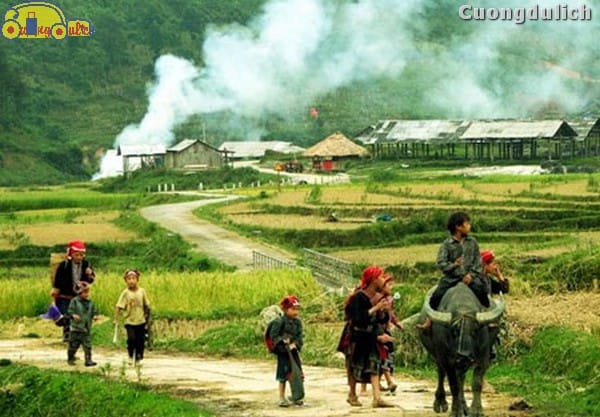
Bản Tả Van Giáy is a place that still preserves many original customs of the indigenous people more than other villages in Tả Van. Bản Tả Van Giáy is the oldest village in Tả Van, located in the Hoàng Liên National Park. Cuong sees many Western backpackers willing to trek deep into the remote villages of Bản Tả Van to explore. You can find your way to Bản Seo Mý Tỉ, located 14 km from the center of Tả Van commune, where there is a very large and beautiful lake, still preserving its pristine beauty as it is lesser-known.
The main occupation of the Giáy people is rice cultivation, so if you wish, you can learn about how they grow rice on terraced fields, see if it differs from the wet rice civilization of the Kinh people. In addition, the Giáy people in Bản Tả Van Giáy also have the craft of making silver jewelry, crafting handmade tools that require skilled and meticulous craftsmanship.
The Giáy ethnic village in Tả Van has a history of over 300 years since the first Giáy people came here to cultivate and establish the village. The village has several large clans such as the Sần clan, Vàng clan, Lù clan, etc., among which according to the village elders, the Sần clan arrived here the earliest. The clans live scattered in villages, hamlets, and valleys at the foot of the mountains, along rivers, streams, surrounded by the Hmong people living nearby. The Giáy people still maintain the traditional cultural features, customs, beliefs, and festivals of their ancestors to this day in an intact manner.
10. Check-in at Cầu Mây in Bản Tả Van
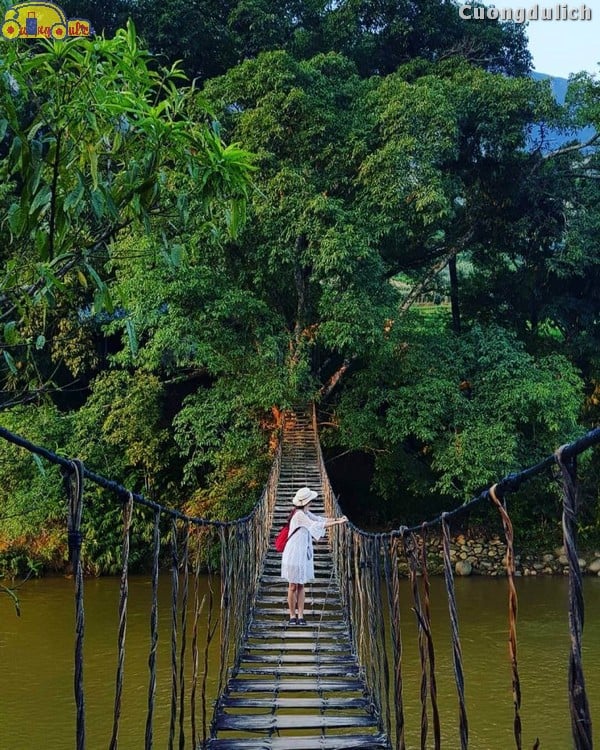
The bridge that once caused a frenzy on social media and even gained fame internationally is the Cloud Bridge in Ta Van village. Since ancient times, the villagers have been creating bridges to cross streams and rivers to facilitate transportation. These bridges are made of forest ropes and thin wooden planks, hence the name Cloud Bridge. Nowadays, most of the bridges crossing streams leading to the village have been replaced with iron bridges for safety. Therefore, the rare Cloud Bridge in Ta Van village is a reason why tourists come to admire and take countless breathtaking photos. However, this bridge has been around for a long time and is quite difficult to walk on, so you need to be careful when walking in the middle of the bridge to take photos, especially during the rainy season when the thin wooden planks can become slippery. Nevertheless, the feeling of climbing on a rope bridge over a stream is quite adventurous and worth trying, especially for young people.
So why does Cuong say that the Cloud Bridge in Ta Van is world-famous? It’s thanks to a photo taken by American photographer Skip Nall of the Cloud Bridge in Ta Van during a trip to Sapa with friends. The photo of the Cloud Bridge climbing in the misty weather was displayed in stores of the Swedish furniture company IKEA and attracted the attention of many travel enthusiasts worldwide. Many tourists, after admiring the photo of the Cloud Bridge, did not hesitate to travel long distances to Vietnam and Sapa, to visit Ta Van village and see this bridge with their own eyes.
Enjoying local specialties in Ta Van Sapa
The delicious dishes in Ta Van village will make you forget the way back, such as grilled mountain stream fish from Muong Hum, Thang Co horse meat from Muong Khuong, armpit pork from Bac Ha, and colorful sticky rice from Van Ban, dishes made from corn, sticky rice, buckwheat, and chicken. Tourism in Ta Van village has developed a lot, accompanied by many good restaurants, so you don’t have to worry about not finding a place to eat. Rest assured that when you leave Ta Van village, you will be full with delicious local dishes, and once you taste them, you will always remember the local flavors.
1. Grilled mountain stream fish:
Sapa mountain stream fish comes in various types and surprisingly, they do not have a fishy taste. When you go on a Sapa tour and eat mountain stream fish, you just need to grill it over charcoal until cooked, then eat it hot right away or grill it slightly, then fry it with tomato sauce and spices like curry powder, black pepper, and you will have a delicious meal. The mountain stream fish here is about the size of 2-3 fingers. The fish is usually green to blend in with the moss-covered rocks. The mountain stream fish has many bones, so people in the highlands only fry it to eat both the bones and the meat, without making soup or stewing it. The fish in the pan, golden yellow, exudes a fragrant aroma. The fish head is plump and crispy, the inside is fragrant and sweet meat, you can even chew the crispy fish bone. Dip the fish in delicious fish sauce mixed with lemon and chili, eat it with boiled watercress and hot rice on a cold evening in Muong Hum, it feels wonderful. In addition to crispy fried fish, locals also love to cook mountain stream fish intestines. They consider it a specialty and a folk remedy to keep men healthy and women youthful. People from the lowlands are afraid to eat fish intestines because they fear stomach upset. Perhaps that’s why the locals, especially men, are fond of tourists because they say: “Locals may fight over fish intestines. People from the lowlands like it too much!”
2. Thang Co:
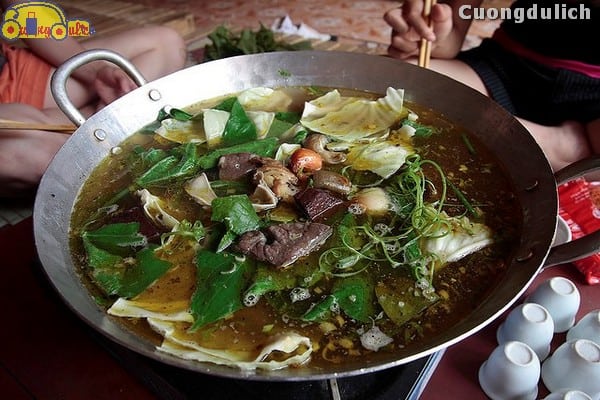
Thắng cố is a popular dish that cannot be missed by the ethnic groups in the Northwest region, especially in the markets of the highland ethnic groups. Originally, traditional thắng cố was only made from horse meat, but later other ethnic groups added beef, buffalo, and pork while also creating many different types of ingredients and cooking recipes. However, the most delicious thắng cố is still the horse thắng cố in Bac Ha, Muong Khuong, Sa Pa – Lao Cai, the homeland of this unique Sapa specialty.
The traditional thắng cố pot contains horse meat, heart, liver, lungs, horse blood… and 12 types of herbs and spices, including cinnamon, star anise, lemongrass, ginger, and many other traditional spices. Among them, the thắng cố tree is the 12th spice. Thắng cố is prepared quite simply. The horse meat and organs are cleaned, marinated with traditional spices. Then, in a large pan, all the meat and organs are stir-fried until the meat is slightly seared, then water is added to the pan and simmered vigorously for hours on a glowing charcoal stove. Organs such as heart, liver, lungs, blood, meat, bones, are added last and simmered, and various vegetables can be added.
When eating, the broth is scooped into a hotpot, and horse meat is added. The accompanying vegetables include water spinach, water celery, cabbage… The dipping sauce is made from a special chili sauce in Muong Khuong that is salty, spicy, and pungent, providing warmth when eaten. The horse organs, when cleaned and cooked, have a very fragrant taste, crispy and delicious. The distinctive taste of horse meat, tender and sweet, combined with the dipping sauce is incomparable.
3. Bac Ha’s Stolen Armpit Pig
The Stolen Armpit pigs are raised in a natural environment and left to roam freely. They are born and left to live in the garden, foraging for wild plants and roots to eat, rather than being fed, bathed, or sleeping in sturdy pens like other pigs. These pigs are usually raised freely for about a year, with the largest ones weighing only 20kg, and the average ones weighing around 10kg. The meat of the Stolen Armpit pig is very firm, sweet, and especially low in fat, and fragrant rather than smelly like pigs raised on growth feed. The feeling when eating Bac Ha’s Stolen Armpit pig meat is that it is not as greasy as fatty pork, and not as dry as wild boar meat, fatty but not cloying, tender but not tough. Typical dishes made from the Stolen Armpit pig include whole roasted meat, grilled skewers over charcoal, etc. If you want to make stir-fries, steamed dishes, or grilled dishes, they are also very delicious. Stolen Armpit pigs are mainly sold at highland markets, where ethnic people gather to exchange goods on weekends. When roasting Stolen Armpit pig meat, a tip is to brush honey all over the pig while roasting. Honey helps the pig’s skin not crack when roasting, giving it a shiny golden color that is very appealing.
4. Grilled Ban Chicken
Ban chickens are raised by ethnic people, left to forage in mountainous areas, so the meat is tough and firm. When in Sapa, Cuong tried the grilled pepper and lime chicken, and you have to eat it hot, the chicken meat is so fresh, fragrant, and tender, I’m craving it just thinking about it. When eating, tear a piece of chicken meat with your hands and dip it in the spicy, fragrant sauce, a new and satisfying sensation!
Some notes when traveling to Tavan Sapa village
- Since Tavan village is located in the high mountains, when traveling, you should prepare warm clothes. Tavan can be very cold in winter, but warmer in spring and summer.
- If you want to stay and explore Tavan village for a few days, you should prepare your ID to register for temporary residence.
- Also, the road to Tavan village is quite winding, so if you have a history of motion sickness, you should take motion sickness medication or choose to travel by motorbike.
- If you visit Tavan village during peak tourist season, it’s best to book homestay accommodation in advance for overnight stays.
- Due to the hilly terrain of Tavan village, with many rivers and streams, rugged roads, it’s best to travel in groups, stick together to ensure safety and be ready to help each other in case of emergencies.
- The prices of food here are quite high. Cuong had a grilled chicken weighing about 2kg for 500,000 VND, a plate of grilled stream fish is… so for those who want to save costs while traveling independently, it’s best to prepare food to bring along or return to town for meals.
Nearby attractions near Tavan Sapa village
1. Lao Chai Village
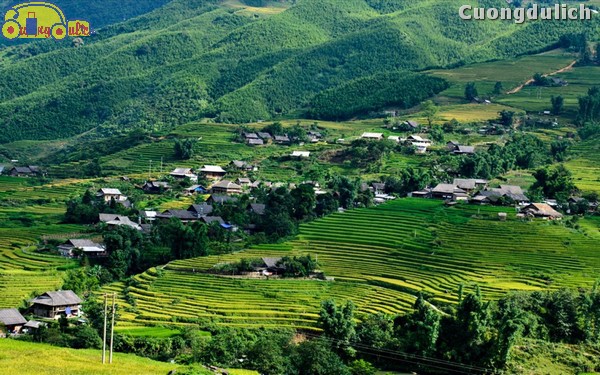
Located 7 km from the town of Sapa, Lao Chai village, like Ta Van village, still preserves the traditions of the ethnic communities passed down through generations.
2. Fansipan Peak
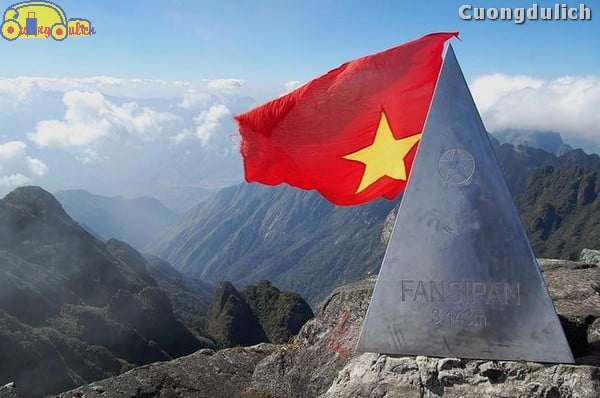
One of the highest mountains in Vietnam. Many tourists visiting Sapa aspire to conquer this rooftop of Indochina. Now there is an easier way to conquer Fansipan peak if you don’t want to climb the mountain: take the cable car.
3. Stone church
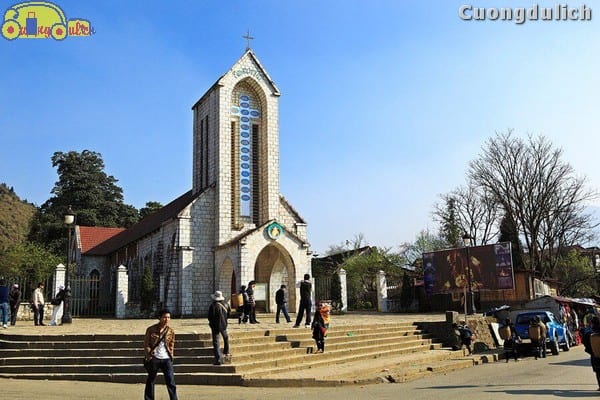
Located in the center of Sapa town, bearing the imprint of French architecture. In front of the church is the central square, where the Love Market takes place on weekends.
4. Cat Cat Village
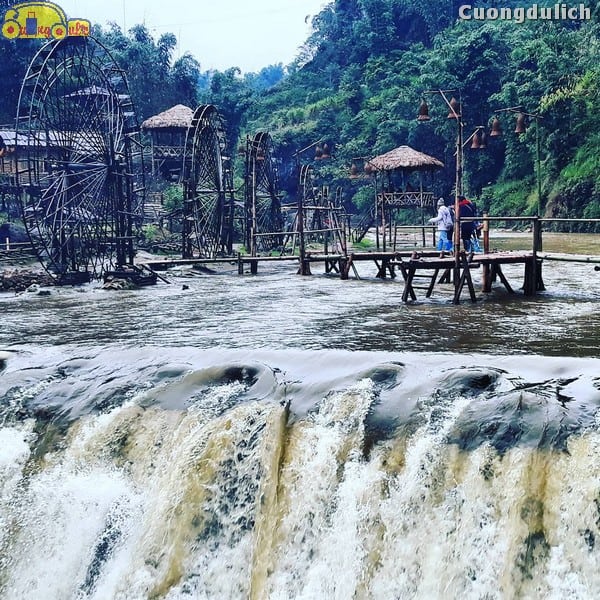
Considered the most beautiful village in the Northwest, located about 3 km from Sapa town. This is seen as one of the must-visit destinations when you travel to Sapa, with many beautiful views such as cool streams, winding bridges, and water mills bringing water to the village.
5. Ban Sin Chai Village
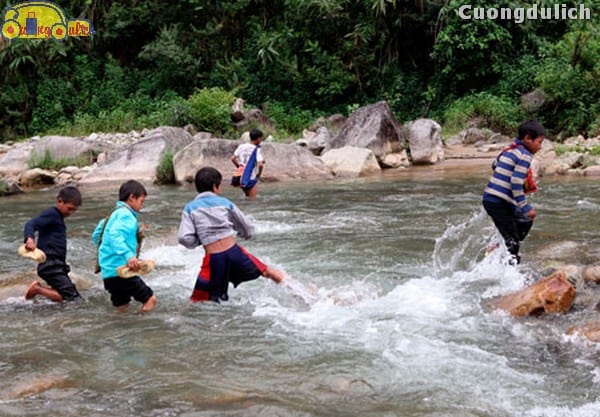
About 5 km from the town of Sapa, very close to Cat Cat village. Tourism services are not yet well developed in Sin Chai village, so this place still retains its wild and mysterious scenery.
So Cuong has provided you with detailed reviews of the experiences when Cuong visited traveling to Sapa and visiting Ta Van village. Hopefully, through Cuong’s introductions, you have discovered a new travel destination in Sapa because Ta Van village is one of the must-visit villages if you want to explore and learn about the lives of ethnic people in Sapa. Wishing you all enjoyable and memorable trips to Sapa.
